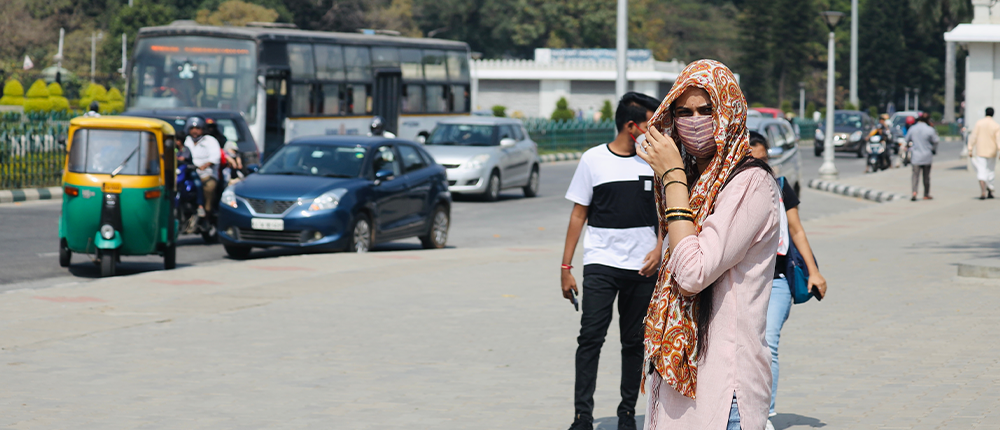Between 1992 and 2015, official estimates recorded 24,223 deaths caused by heatwaves, earning it the labels of a “silent killer” or an “invisible disaster.”

According to the National Heat-Related Illness and Death Surveillance (NHRIDS), in 2024, there were 48,156 suspected heatstroke cases, 269 suspected heatstroke deaths, and 161 confirmed heatstroke deaths. However, independent reports such as Heat Watch 2024 paint a graver picture—reporting 733 heatstroke-related deaths across 17 states between March and June alone. Despite the discrepancies in official and independent figures, the increasing frequency and severity of heatwaves, and their deadly toll, cannot be ignored.
Between 1992 and 2015, official estimates recorded 24,223 deaths caused by heatwaves, earning it the labels of a “silent killer” or an “invisible disaster.” Unlike other natural disasters, heatwaves often escape public attention due to their slow onset and difficulty in attributing a single cause of death.
The India Meteorological Department (IMD) forecasts an early onset of higher temperatures and prolonged heatwaves from April to June in 2025, following 2024, being recorded as the hottest calendar year globally, according to the World Meteorological Organization (WMO). Climate change is pushing annual temperatures higher, intensifying heatwave conditions. This is particularly alarming given that around 57% of Indian districts—home to approximately 76% of the country’s population—are exposed to high levels of heat. The scale and intensity of heatwaves continue to escalate due to recurring climate-induced extreme weather events.
Current Policy and Institutional Response
In response to these growing threats, the Central Government introduced the National Guidelines for Preparation of Action Plan – Prevention and Management of Heat Wave in 2016, with subsequent revisions in 2017 and 2019. To address health risks from climate change more broadly, the National Action Plan on Climate Change and Human Health (NAPCCHH) was also added to the broader National Action Plan on Climate Change (NAPCC).
An adaptive strategy has been put in place through a partnership between the IMD and the National Disaster Management Authority (NDMA), including the introduction of a Heat Index for states most vulnerable to extreme heat. Currently, the Government of India is collaborating with 23 states and over 130 cities and districts to develop Heat Action Plans (HAPs). These plans typically outline short-, medium-, and long-term strategies focused on early warning systems, public awareness, cooling infrastructure, and capacity-building.
Challenges in Addressing Heatwaves
While HAPs have become the cornerstone of local and state-level responses, significant challenges persist across policy, finance, and governance domains. Critically, heatwaves are not yet classified as a “Notified Disaster” under the Disaster Management Act, 2005. The 15th Finance Commission excluded heatwaves from the list of eligible disasters for central relief funding. Although states are allowed to use a portion of their State Disaster Response Fund (SDRF) for local disasters, this is insufficient given the rising frequency and duration of heatwaves.
This classification gap places the financial burden on states, requiring them to declare heatwaves as “state-specific disasters” to access even limited support. While national agencies like NDMA, IMD, and the Ministry of Health have pushed for early warnings and mitigation, the scale of intervention remains inadequate. Most city-level HAPs lack transparency, accountability, and designated funding, making implementation highly uneven.
It is also essential to understand how heatwaves differ from conventional disasters. There is no sudden, dramatic impact as in the case of floods or earthquakes. Instead, heatwaves impose a prolonged and uneven burden, depending primarily on an individual’s exposure and adaptive capacity.
Blue-collar workers, such as construction labourers, street vendors, and agricultural workers, are particularly vulnerable due to constant outdoor exposure. Additionally, the growth of gig work and quick-commerce platforms has created a new category of at-risk individuals, notably delivery agents, who face extreme heat without safeguards.
The current policy interventions do little to acknowledge or address the socio-economic fallout of heat-related stress. A World Bank study estimates that nearly 75% of India’s workforce—about 380 million people—are exposed to heat in their daily work, with projections suggesting that 80 million jobs could be lost due to heat stress, mostly in informal and blue-collar sectors.
Way Forward
To tackle the socio-economic risks of heatwaves effectively, bold and inclusive policy reforms are urgently needed. Given the interplay between climate change and social vulnerabilities, a holistic, multi-level governance approach is critical—from the national to the city level.
A long-term vision must be embedded in national and sub-national strategies, with emphasis on funding, infrastructure, and institutional capacity. This includes:
- Reviewing and evaluating existing Heat Action Plans to identify gaps and areas for strengthening. This could include assessing the current HAPs and initiating a dialogue across cities for gap assessment and institutionalization of the implementation plans.
- Collaborating closely with vulnerable cities to develop sustainable cooling infrastructure and implementing strategies to alleviate urban heat island effects through nature-based solutions. The existing schemes such as AMRUT and PMAY can be leveraged to promote heat-resistant infrastructure in heatwave-prone areas, specifically for vulnerable populations.
- Designing local heat vulnerability thresholds and indicators that reflect real-time risk also becomes critical to ensure localized action strategies. Further, building framework at national and local levels for regular monitoring and updation.
- Implementing local early warning and predictive systems to anticipate surges in energy demand, service disruption, and health emergencies.
- Health insurance cover could be ideated to address the vulnerable worker groups that have high exposure to heat-related health stresses. This could be a more dynamic insurance cover that considers the incidence of heatwaves in high-risk areas and develops a safety net in case of heatwaves.
Above all, moving from reactive responses to proactive resilience-building for the millions already living on the frontlines of rising heat needs to be a cornerstone of a future-ready heatwave response strategy. Heatwaves are no longer rare; seasonal anomalies—they are becoming a deadly norm in a warming world. To protect lives, livelihoods, and the economy, resources, both financial and institutional, must be mobilized at all levels of government in a coordinated manner for a resilient tomorrow.
